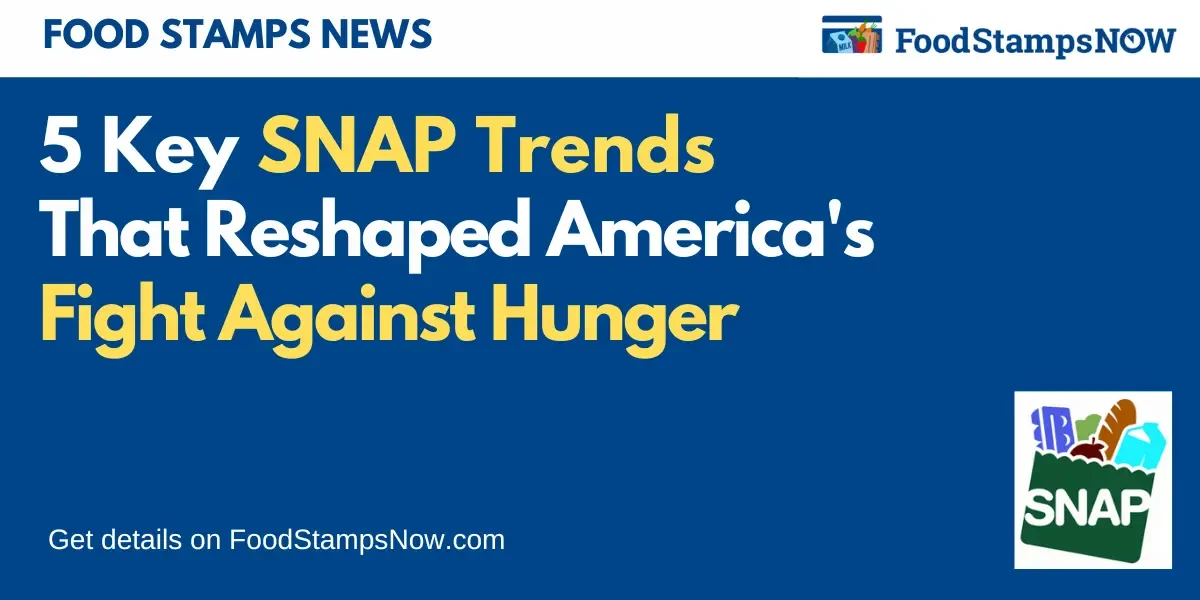In this post, we will analyze 5 key SNAP trends from 1969-2022 using data from the United States Department of Agriculture. The Supplemental Nutrition Assistance Program (SNAP), initially known as the Food Stamp Program, has been a vital part of America’s social safety net for over half a century.
Since its inception in 1969, SNAP has evolved dramatically, adapting to the changing economic landscape and shifting needs of the population.
This blog post delves into five pivotal trends from 1969 to 2022, uncovering how SNAP has grown and transformed in its mission to combat hunger and food insecurity in the United States.
By examining these trends, we gain insight into the program’s impact, its challenges, and its enduring significance in American society.
NEW: Summer EBT Benefits for 2024

5 Key SNAP Trends from 1969-2022 (That Reshaped America’s Fight Against Hunger)
Here are the 5 key SNAP trends from 1969 – 2022 after analyzing data from the USDA.
1. The Remarkable Rise in Participation
Starting in 1969 with just under 3 million participants, SNAP’s journey has been marked by a phenomenal increase in reach.
The most striking growth occurred during periods of economic distress.
For instance, during the 2008 financial crisis, SNAP participation skyrocketed, jumping from 26.31 million in 2007 to an unprecedented 47.64 million by 2013.
This spike mirrored the nation’s struggle and highlighted SNAP’s role as an economic stabilizer.
2. The Evolution of Benefits: From Modest Assistance to Significant Support
In 1969, the average monthly benefit per person was a modest $6.63, barely enough to supplement a family’s food budget.
Fast forward to 2022, and the average benefit had surged to $121.26 per person, a staggering 18-fold increase.
This growth wasn’t just due to inflation; it reflected deliberate policy decisions to enhance the program’s effectiveness in reducing food insecurity.
3. The Billions Behind the Benefits: Analyzing SNAP’s Financial Footprint
From a total expenditure of $250.5 million in 1969, SNAP’s financial footprint expanded massively to $79.73 billion in 2022.
This increase in spending speaks volumes about the program’s scaling up to meet growing needs.
It’s not just the sheer numbers; these billions represent a commitment to fighting hunger.
4. Responding to Crisis: SNAP’s Agility in Times of Need
SNAP’s ability to respond swiftly to crises has been a hallmark of its effectiveness.
During the COVID-19 pandemic, for example, SNAP adapted quickly, providing increased benefits and easing eligibility requirements.
For example, during the pandemic, Congress temporarily increased SNAP benefits in two ways:
First, it raised all benefits by 15% and boosted every household to the maximum benefit for their household size.
Second, Congress directed the USDA to study the costs required to purchase a healthy diet.
As a result, SNAP benefit amounts have been permanently adjusted as of Oct. 1, 2021, to provide 40 cents more per person, per meal.
This responsiveness not only offered immediate relief but also showcased the program’s critical role in bolstering societal resilience during unforeseen challenges.
5. The Future Trajectory: Adapting to New Challenges
As we look beyond 2022, SNAP faces new challenges, including rising food prices and changing demographics.
The program’s past adaptability and growth suggest a readiness to meet these challenges head-on.
Future policies may focus on further improving accessibility and addressing nutritional quality, ensuring SNAP continues to be a vital part of America’s social safety net.
Summary – 5 Key SNAP Trends
Reflecting on SNAP’s journey from 1969 to 2022 reveals much more than just the mechanics of a welfare program.
The program’s evolution, marked by increasing participation, enhanced benefits, and significant financial investment, underscores its crucial role in providing a safety net for millions.
As SNAP continues to navigate the challenges of the 21st century, it stands as a testament to the collective effort to ensure no American goes hungry.
The future of SNAP, while certain to face new challenges, holds the promise of continued innovation and adaptation, ensuring its place as a cornerstone in America’s fight against hunger.
Questions?
We hope this article on 5 Key SNAP Trends was helpful to you.
If you have any additional questions about the SNAP Schedule for December 2023, please let us know in the comments section below.
Related Article: Food Stamps Increase for October 1st, 2024
In the meantime, be sure to check out our other articles on SNAP, EBT and Food Stamps:
- Extra Food Stamps for 2024
- Free Christmas Gifts for 2023
- EBT Card Discounts by State (2023)
- Discounted Amazon Prime for EBT Cardholders
- How to get $10 Internet with Food Stamps
- Stores that accept EBT Online for delivery

